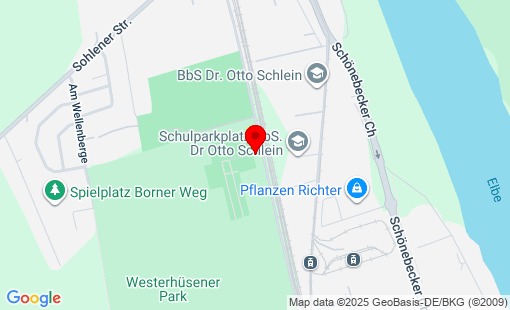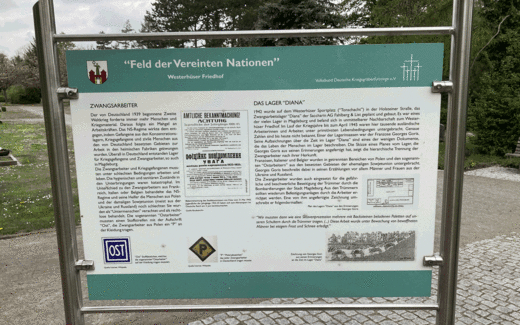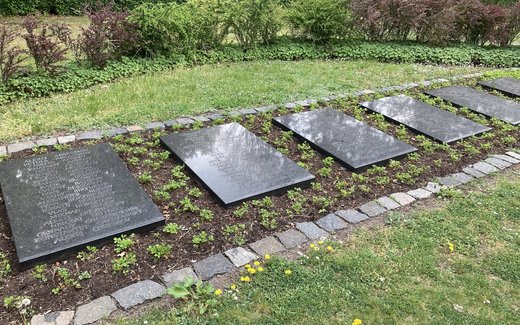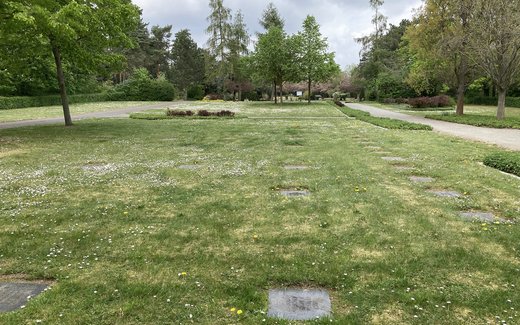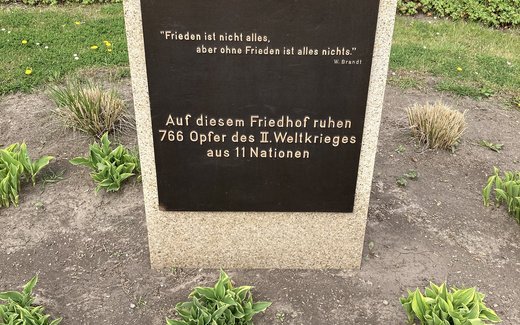The district of Westerhüsen in the south of the city of Magdeburg was incorporated in 1910.
The Westerhüsen cemetery dates back to 1908.
in 1942, the "Diana" forced labor camp was established north of the cemetery. The
mainly from Eastern Europe were imprisoned there and had to work in the nearby
Work at the nearby Fahlberg-List chemical plant. Due to the poor
Living conditions, there were many deaths, including children born in the camp
Children born in the camp. In the early summer of 1941, a free section in the southern part of the
Of 1500 m² was fenced off from the cemetery. On this part of the
Westerhüser cemetery was used between 1941 and 1945 to bury the deceased
Forced laborers, prisoners of war and prisoners of the concentration camps
Magdeburg concentration camps, especially the "Diana" camp. The cemetery at the
Westerhüser cemetery was chosen because it was located away from residential areas
residential areas and was already extensively fenced in. The surrounding trees provided additional
additional privacy from the outside.
Among the dead who came from Eastern Europe, Russians, Ukrainians and Poles made up the largest groups
the largest groups. The official burial lists indicate Czechs, Serbs,
one Latvian and even two Chinese. In total, there are or were dead from
eleven nations were buried here.
After the end of the war, this so-called "foreigners' cemetery" was closed until
1947 on the instructions of the Soviet military administration and named in honour of the
and named "Field of the United Nations" in honor of the United Nations founded in 1945
Nations" in honor of the United Nations founded in 1945. A monument from this period with a hammer and sickle can still be found
still stands next to the burial grounds today. The gravestones were, like the
Grave borders, were made of gray concrete artificial stone.
In the period from 1945 to 1950, various dead people buried here were
exhumed and transferred to their home countries, such as France, Belgium, Denmark, Holland and Norway
and Norway. Exact details have not survived, so it is not possible to
exact numbers of the dead buried in the cemetery cannot be given.
In 1995 and 1996, the cemetery was redesigned to its present form
and provided with new grave markers. in 2005, a memorial stone was erected in front of the
Entrance to the cemetery on Holsteiner Straße was erected to commemorate the
Victims of the war and their fate.
Together with the city of Magdeburg, a weatherproof, metal name book and an information board were erected in 2009
Book of names and an information board were erected in 2009, providing visitors with more
Information about over 800 people who rest here and the circumstances of their deaths
and the circumstances of their deaths. The names of the dead are listed for each grave block in alphabetical order
Listed in alphabetical order. Furthermore, details of the dates of life and the country of
Country of origin, insofar as these are known.
War graves such as those in the "Field of the United Nations" commemorate the sad
Of the past and are permanently preserved as memorials against hatred and violence
And violence. In this way, future generations will be made aware of the consequences of war
of war and violence. The name book for the dead is intended to
Visitors to the cemetery the opportunity to find out more about the dead on the basis of their
To find out more about the deceased on the basis of their dates of life and origins. Behind every name is a
Life and behind every person is a fate
Germany
Magdeburg-Westerhüsen
Total Occupation: 766 fatalities
Total Occupation: 766 fatalities
Contact
Contact
Holsteiner Str. 46A
39122 Westerhüsen, Feld d. Vereinten Nationen
Germany
